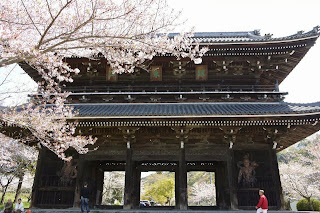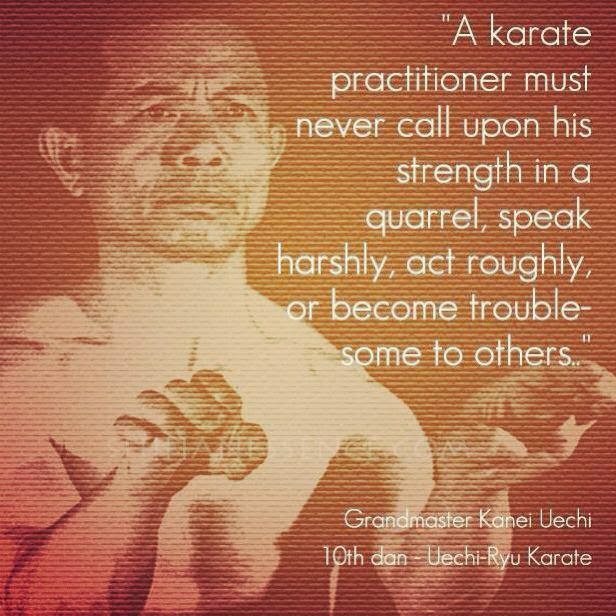About All Okinawa Life Protection Arts. Examining Nago City Kenpo, Tomari-Tii, Naha-Tii, Shuri-Tii & Ryukyu Kobudo Innovators, Style founders and major figures in Okinawan Karate
Saturday, May 10, 2014
Tuesday, August 5, 1997
SHORINJIRYU RYUJIN RYUKYU TiiJUTSU
Go Shin Jitsu Kenpo [ SHORINJIRYU KARATE ] A Punching Art, is suited for A lifelong practice.
The roots of this fighting system, may be found in the traditions of 'Meng-Hee-Kwan'.
Evasive tactics and simultaneous strikes (in all fighting ranges) are the trademark of
 this style. Shorinjiryu Ryujin Tiijutsu is A living Art , constantly adapting and changing.
this style. Shorinjiryu Ryujin Tiijutsu is A living Art , constantly adapting and changing.
Its purpose is : Combat Strategy and Rapid Response to aggression. As such , it is
not innately geared towards competition.
Shorinjiryu Tiijutsu is A symbiotic balance of External (hard)and Internal (soft) practice.
Go-no-Tii (young practice) and Mai-no-Tii (aged practice) provide An equilibrium in
 teaching and learning , which ensures longevity and dedication in continuous practice.
teaching and learning , which ensures longevity and dedication in continuous practice.



There are Three Primary Katas in Shorinjiryu Ryujin Tiijutsu : Naifanchin* (Daipochin,
Koryu); Sanchin* (Trican, Sam Chien, 3 Battles); Sanpabu* (Motobu Ryu Udon Tii)
Shorinjiryu Tiijutsu is A holistic system ; emphasizing cultivation of Psycho-physical
Energy , Dynamic Tension , and Body-science Mechanics. In addition , auxiliary
longevity Exercises, Resuscitation Techniques and Symmetrical Breathing practices
 are incorporated in the Shorinjiryu regimen.
are incorporated in the Shorinjiryu regimen.
Shorinjiryu Tiijutsu's pragmatism lies in its practice of explosive Muscle-Memory
response and Spontaneous Adaptation to any combat situation.
Spiritual development , adherence to Pugilistic Integrity , and Meditation practice, are
essential traits in the Path of A Shorinji-Do Warrior.
The roots of this fighting system, may be found in the traditions of 'Meng-Hee-Kwan'.
Evasive tactics and simultaneous strikes (in all fighting ranges) are the trademark of
 this style. Shorinjiryu Ryujin Tiijutsu is A living Art , constantly adapting and changing.
this style. Shorinjiryu Ryujin Tiijutsu is A living Art , constantly adapting and changing.Its purpose is : Combat Strategy and Rapid Response to aggression. As such , it is
not innately geared towards competition.
Shorinjiryu Tiijutsu is A symbiotic balance of External (hard)and Internal (soft) practice.
Go-no-Tii (young practice) and Mai-no-Tii (aged practice) provide An equilibrium in
 teaching and learning , which ensures longevity and dedication in continuous practice.
teaching and learning , which ensures longevity and dedication in continuous practice.


There are Three Primary Katas in Shorinjiryu Ryujin Tiijutsu : Naifanchin* (Daipochin,
Koryu); Sanchin* (Trican, Sam Chien, 3 Battles); Sanpabu* (Motobu Ryu Udon Tii)
Shorinjiryu Tiijutsu is A holistic system ; emphasizing cultivation of Psycho-physical
Energy , Dynamic Tension , and Body-science Mechanics. In addition , auxiliary
longevity Exercises, Resuscitation Techniques and Symmetrical Breathing practices
 are incorporated in the Shorinjiryu regimen.
are incorporated in the Shorinjiryu regimen.Shorinjiryu Tiijutsu's pragmatism lies in its practice of explosive Muscle-Memory
response and Spontaneous Adaptation to any combat situation.
Spiritual development , adherence to Pugilistic Integrity , and Meditation practice, are
essential traits in the Path of A Shorinji-Do Warrior.
Labels:
aggression,
balance,
behzad,
bojutsu,
budo,
combat . fight,
external,
internal,
karate,
nihanchikata,
okinawa,
punching,
ryujin,
sanchin,
sanpabu,
sensei,
shorinjiryu,
tiijutsu
Location:
Albany, NY, USA
Thursday, February 15, 1996
"FA~JIN" in Martial Arts : Sanchin Kata & Shime
THE FA~JIN PRINCIPLE
THE EXPLOSIVE POWER IN MARTIAL ARTS
Basic translation of 'Fa-Jin' may be construed as___'Release of Power'__However this A very narrow definition and does not really convey the essence of what this simple yet complex principle embodies.
In Martial Arts, the three(3) components of "Yi" , "Qi" and "Li" have to combine in A congruent alignment to achieve : FA-JIN.
"Yi"~ may be construed as the command or "INTENT", initiated in the Mind, But Released incrementally downward and out [Related to the Brain].

"Qi"~ is perceived as the bio-electrical energy which ''FLOWS'' within the
physical body and outward [Related to Skeletal body & beyond].
"Li"~ the explosive muscular 'power' generated from the 'core' energetic
reservoir, "ACTIVATED" in the physical body [Related essentially to :
Kidneys* , Liver , Lungs & Heart Functions].
* Basically, Physical Body's 'Batteries'.
http://youtu.be/-WBCwi6qyC
SANCHIN KATA SHIME (gitae)
Iron Body Training & Conditioning
FA~JIN is not A brute force, but rather A refined filtered , Intentionally Directed Power. If we consider the "Iron Shirt" practiced by Gung-Fu practitioners, who subjected their bodies to being struck by A harnessed tree trunk; then "Fa-Jin" is like A Laser Strike. It is similar to being hit by an steel dart/arrow , which affects the body internal (organs). It has A disruptive 'shock force'. An explosion of energy (implosion of Prana)
The force of FA~JIN is associated with the mythical powers of the Dragon. The true nature of this Force is relaxed yet highly focused Intentionally. The Coiling power of A Snake, aptly demonstrates the energy release of this principle.
FA~JIN is developed progressively through continued practice of modalities such as Qi-Gung , Sanchin Kata, Yoga practice, etc. It relies for the most part, on the concept of being soft(sung) on the outside. This principle is witnessed extensively in the Nun Chuan (Southern Fist) styles of Gung-Fu and Kempo and in hard/soft styles of Toudi and Ryukyu-Tiijtsu, that have maintained their Chinese influences.
Advanced "Fa-Jin" practitioners develop their bodies from inside out, to safeguard from injuries by those who know how to unleash "Fa-Jin's" explosive power. Mastering the "opening and closing" of Energetic Gates, Dynamic Tension muscle control, Deep Focused Relaxation ; advanced practitioners avoid serious internal injuries , which in some cases have proved fatal.
In Toudi/Kempo and Tiijutsu/Karate circles, this advanced concept is referred to as "being soft on the outside . . and hard on the inside". In Ancient China : "Rou-Zhong-Hang-Gong'' , embodied this concept of Hard within Soft (Yang/Yin)
Sanchin Kata
Ahmadi Behzad, Narashbi (Shinshi)
Ryukyu Shorinjiryu Ryujin TiiJutsu
www.Shorinjiryu.weebly.com
www.youtube.com/user/bozAmadi
REFERENCE :
White Crane Gung Fu
Zhan-zhuang
Jing or Ging
Tiijutsu / Toudi
Aikido
Babulien
MingHeKwan
Kundalini
Zen-kido
Zu Zhang
Therapeutic Movement
Pneuma & Prana
Qi-Gung / Tai Chi
Ayangar
SANCHIN KATA & SHIME (gitae)
Saturday, April 22, 1995
"NAGO" : The Other Karate City
The Karate of Shigeru Nakamura
Nago (Uchina : Nagu) City in the North of Okinawa, (located South East of Motobu). It is thought to be A periphery in Karate/Kempo circles. Most people know Naha-te (Commerce & Trade center), Shuri-te (Government & Political center) and Tomari-te (Major Fishing Port), but very few people are aware that Nago-te (Okinawa Kenpo), is also An important Ryukyu Karate center.
Those who are mainly responsible for spreading the fame of Nago City are firstly Shinkichi Kuniyoshi and his heir, Shigeru Nakamura. Nakamura Shinshii, established what eventually became Okinawa-te and Ryukyu Kenpo. He was first taught by his uncle Teiichi, and then by such notable teachers as : Hanshiro Chomo (ShuriTe) and Kentsu Yabu (ShuriTe), Choki Motobu (TomariTe), Kanryo Higashionna (NahaTe), and Seikichi Kuniyoshi (NahaTe).
Nago (Uchina : Nagu) City in the North of Okinawa, (located South East of Motobu). It is thought to be A periphery in Karate/Kempo circles. Most people know Naha-te (Commerce & Trade center), Shuri-te (Government & Political center) and Tomari-te (Major Fishing Port), but very few people are aware that Nago-te (Okinawa Kenpo), is also An important Ryukyu Karate center.
Those who are mainly responsible for spreading the fame of Nago City are firstly Shinkichi Kuniyoshi and his heir, Shigeru Nakamura. Nakamura Shinshii, established what eventually became Okinawa-te and Ryukyu Kenpo. He was first taught by his uncle Teiichi, and then by such notable teachers as : Hanshiro Chomo (ShuriTe) and Kentsu Yabu (ShuriTe), Choki Motobu (TomariTe), Kanryo Higashionna (NahaTe), and Seikichi Kuniyoshi (NahaTe).
Saturday, April 3, 1993
DAN RANKING OKINAWA-Tii 1st to 10th dan black t
RYUKYU DAN RANKING SYSTEM is based on the SHURI CASTLE COLORS :
 * BLACK * SILVER * RED * GOLD *
* BLACK * SILVER * RED * GOLD *1 to 3rd DAN BLACK Belt with SILVER stripe (Lengthwise)
4 to 6th DAN BLACK Belt with GOLD stripe (Lengthwise)
7 to 9th DAN RED Belt with GOLD stripe (Lengthwise)
10th DAN Solid GOLD OBI
SHORID S NJIRYU RYUJIN T
SHORINJIRYU RYUJIN TiiJUTSU DAN RANKING
1st to 4th : SOLID BLACK BELT (Calligraphy : Style & Name)
5th Dan : Black and White (Sectional Belt) with White Ends.

6th to 8th Dan : Black & White (Sectional Belt) "1" "2" "3" Black Stripes (Widthwise)
9th Dan : Black & White (Sectional Belt) with Gold & Red Ends (lengthwise)
10th Dan : * * Solid Gold Belt * *
DAN RANKING IN OKINAWA KARATE 1ST IIIIII TO 10TH DAN
OTHER Ryukyu Styles :
In some Okinawan Styles 1st to 5th Dan Wear Plain Black Belts
 6th Dan One Stripe , 7th Dan Two Stripes , 8th Dan Three Stripes
6th Dan One Stripe , 7th Dan Two Stripes , 8th Dan Three Stripes9th Dan Solid Red Belt , 10th Dan Solid Red with White Tips.
Thursday, October 10, 1991
The ISSHINRYU Dilemma
Tatsuo Shimabuku : 'One Heart Way" Karate
Shimabuku with his first generation : Eiko Kaneshi (seated second from left)


Shorinjiryu & Isshinryu are commonly banded together as are Goju-ryu & Uechi-ryu ( assumed to be A brother/sister Style) , but that is A commonly misconstrued notion; since each style has its own distinctive characteristic.
Shimabuku's adoption of Tate Zuki, instead of Choku (seiken) Zuki, led to A rift with Kinjochin Sako, and his being replaced by Kaneshi Eiko.
Shimabuku's main reasons for switching to A vertical fist (utilized in Chinese Boxing Styles like Wing Chun), was that he perceived that it was more ergonomic and efficient way to punch, and less chance of the thumb being caught on the opponent and thus injured. It is proven advantageous in number of successive punches ( 2 : 3 Ratio )

Shimabuku with his first generation : Eiko Kaneshi (seated second from left)


Shorinjiryu & Isshinryu are commonly banded together as are Goju-ryu & Uechi-ryu ( assumed to be A brother/sister Style) , but that is A commonly misconstrued notion; since each style has its own distinctive characteristic.
Shimabuku's adoption of Tate Zuki, instead of Choku (seiken) Zuki, led to A rift with Kinjochin Sako, and his being replaced by Kaneshi Eiko.
Shimabuku's main reasons for switching to A vertical fist (utilized in Chinese Boxing Styles like Wing Chun), was that he perceived that it was more ergonomic and efficient way to punch, and less chance of the thumb being caught on the opponent and thus injured. It is proven advantageous in number of successive punches ( 2 : 3 Ratio )

Location:
Vermont, USA
Subscribe to:
Posts (Atom)











































